
Looking at Positano as we pass by the bus.
The last time I was in Italy, I did exactly as the 1954 romantic comedy Roman Holiday encouraged. I tossed a coin into Trevi Fountain, assuring my return to Rome. Unfortunately, the movie had the ritual backwards. You stand with your back to the fountain and toss the coin over your right shoulder (where the angels sit), not your left as the movie depicted and which is where Italian Catholics believe the Devil sits. Tossing over your left shoulder might mark your return with misfortune. Maybe that’s why on this trip to Italy four years later, I didn’t make it back to Rome, and as for the misfortune, I can’t blame it on Italy or the coin toss.
Misfortune implies “missing being fortunate”, so sure, considerable airline delays for the bulk of our 18-member group’s fractured arrivals for this two-week Sicily-Southern Italy tour was a rocky and exhausting start. Then I spied the Hallmark Movie good looks of our dark curly-haired Tour Director Andrea F. waiting for arrivals at the Catania–Fontanarossa Airport and the situation brightened as big as his warm smile.
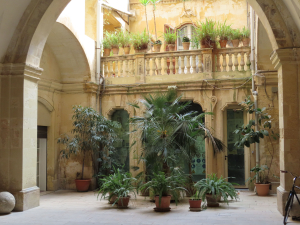
A quiet inner courtyard are common to homes in Lecce.
After cancelling trips or having them cancelled since 2019 and having this Odysseys Unlimited Sicily-South Italy tour rescheduled three times (with participants being shuffled from one date to another), we did wonder if we were defying fate by still travelling. In the few years since our last trip to Switzerland, Austria, and Germany*, COVID had emerged and surged.
Everything about travel was more tedious and difficult. Airlines cut schedules. Countries debated mask and vaccination requirements, changing and tightening regulations as often as some people change their towels. Documentation paperwork exponentially exploded. We purposely uploaded all the requisite forms to our phones, but just in case, carried printed copies of pages and pages of new European Travel forms (no longer necessary), vaccination records, official IDS, and health insurance cards. We bought pricy travel insurance recommended by our tour company’s business partner that was to cover illness (including COVID), something we’d never done or thought important. Bewilderingly, we realized we’d forgotten our honed techniques for packing our luggage, now burdened with COVID test kits and wet wipes.
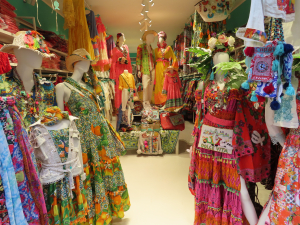
Bright colorful designs with tassels fringe trended from Southern Italian shops.
But we were finally in Sicily, ready for an adventure we’d planned for the past year with another couple, Dave and Vivian W, with whom we had become fast friends during an Odysseys Unlimited tour to Denmark and Norway** years earlier. We had tried booking other trips during the COVID-surge years, all of which fizzled. We were all fully vaxxed and boosted and felt comfortable the airlines still required masks and that Italy enforced masks on transportation and inside buildings. Russ and I trusted that Odysseys would take every precaution to protect us as much as humanly possible as they had on our previous seven tours with them.
I confess. Other than having friends from Sicilian ancestry and watching Stanley Tucci explore the cuisine of the area in his TV series, my knowledge of Sicily stopped with New York gangsters in old movies. From reading the itinerary, I knew eating would play a prominent position on this tour. I was pretty sure if I met any mafioso it wouldn’t be while playing tourist in churches, castles or shops selling themed magnets and shot glasses. I also knew that Odysseys would have informative local guides who knew the historic tidbits likely not included in WIKIpedia or Google searches and that we would have access to sites and experiences not found in daily guidebooks. I knew some of the hotels would be historic treasures with rooms individually sized and decorated, while others would be more vanilla in their modernity but likely centrally located.
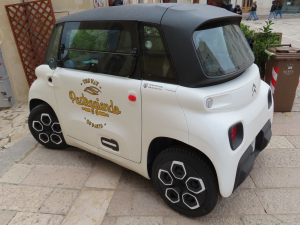
Big pizzas delivered in little cars!
I also knew the tour participants would draw from across the United States, would be well-travelled (or wish to be), on time, flexible for last minute schedule changes, and have a myriad of professional backgrounds. Someone once asked me how we could risk travelling with a group of strangers. I won’t lie and say we’ve never encountered someone with whom we’d prefer not to be near, but this group was a harmonious blend of wonderfully diverse and amiable souls. We had lawyers, geologists, and those in service to the government. We had a jury consultant, cancer research adviser, and one couple who had dated in their teens, lost touch, and 40 or 50 years after both became widowed, re-met, married, and now spend their lives travelling across the globe. Our blessings included a gold-standard guide with a relentless can-do attitude and the overt personality and professionalism of a theater actor (which he also is).
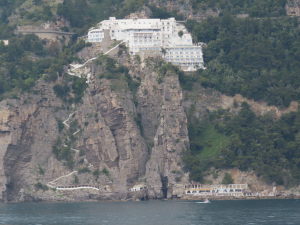
A hotel perches on the edge of the Amalfi Coast.
We arrived at Orlando International Airport at 6:30 a.m for our flight to Dulles (Washington DC). TSA-pre scanner was broken so we were hurried through. The food court bustled with long lines and few empty tables. Opted for Nature’s Table. What a mistake. Disorganized chaos. Finally got our food. My piece of spinach-bacon quiche was cold, unappetizing, and inedible. We had a five-hour layover before our flight to Munich, Germany, so we planned for a better meal at Dulles.
Few options. The best looked to be Chef Geoff’s sit-down restaurant. His personally branded cabernet sauvignon wasn’t much to speak of, but the food was handcrafted and hearty. Russ had a juicy burger with fries. I enjoyed a chicken shawarma and garbanzo bean salad. United Airlines’ catering had forgotten to deliver anything other than some pseudo-Indian vegetarian dish for the evening meal, so we were thrilled not to be hungry.
Russ and I had paid extra for premium economy seats. For that we got about two inches longer seats on the end of a middle section of four. However, there was only foot access for three. The best I could do was sit somewhat side-splayed for the overnight flight. Lesson? Ask what you receive for the money as every airline and airplane is a tad different.
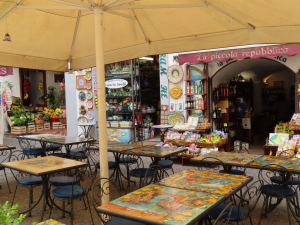
Festive Italian restaurant.
Our flight was delayed. (Doesn’t it seem that plane repairs are cited for delays as often as bad weather? Don’t know about you, but that does not make me feel safer that they are just discovering a problem right before departure.)
That delay meant we barely made our connecting flight in Munich to Catania. Don’t know how you feel, but it seems whenever we transfer in a foreign country, our next flight is always at the farthest most point across the airport. By the time we reached Catania (about 22 hours after leaving home), I was ready for anything that didn’t have to do with sitting at an airport or on a plane!
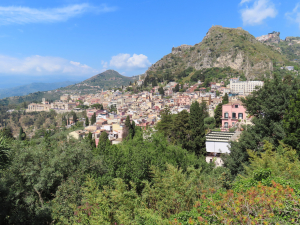
Taormina sits high on the east coast of Sicily overlooking the Mediterranean Sea.
TAORMINA, SICILY
Before reading the tour itinerary descriptions of Taormina I knew it must be a trendy tourist town. Three different groups of people Russ and I know from our wine club were all visiting Taormina in the next two weeks. What I knew for sure is that the food and wine would be impeccable. The city sits high on the east coast over the Mediterranean Sea and Mt. Etna is not far away.
Taormina is so much more than that. Depending on who you ask, Taormina was settled by Greeks back in 734 BCE or maybe in 832 BC when Greek settlers founded a town called Naxos below Mount Tauro. The population of Naxos then founded Taormina. The influences of Greeks and the later occupying Romans left imprints on the architectural designs, language, and of course, on the food and wine. Today there are about 7,000 people within the city and another 4,000 in the suburbs. The streets remain small enough for a wagon to have been pulled on uneven stones. Religious statues, churches, and building designs tell the ancient story of conflict and ritual embedded with folk tales. Folkloric superstitions continue. For instance, pinecones appear in paintings or are sold in souvenir shops. The pinecone began as a symbol of fertility that sprang from a legend of monsters with goat bottoms and human torsos, always holding a pinecone. Today you gift a pinecone to people for luck and prosperity.
Narrow side streets steeply rise and fall. Half-a-dozen café tables signal yet another restaurant sending out smoke signals of rich sauces, freshly made pasta, and of course, pizza. Artisan shops of colorful pottery, herbs, and soaps redolent of lemon are crammed into spaces as small as a child’s bedroom. Artistically crafted marzipan fruits decorate storefront bakery windows.
Recycled stones are used for archways and carved doors. Churches facing the water were fortified against invaders and now buttress erosion from natural elements and too many people in too little a space. The town hall has three Stars of David carved into the façade. About 10% of the town’s population (about 220) were Jews who lived there peaceably until the Spanish Inquisition. Estimates are that by 1500, Sicilian Jews had either been killed, left, or converted. By the end of WWII, there were no more Jews in Taormina. The stars were etched into the town hall’s façade to commemorate them.
where we stayed:
I thought the view from our fifth floor Eurostars Monte Tauro balcony overlooking the jagged coastline, sparkling blue water, and the outline of Mt. Etna was spectacular until I stopped at the eighth-floor deck outside registration to eye the scenery. Just wow. The boutique hotel has 98 individually sized and styled rooms, a seventh-floor breakfast room, and a casual bar that sits alongside the pool. When we first arrived, hunger pangs demanded a snack and glass of celebratory wine for having finally arrived. Our waiter spoke little English but understood Russ’ margarita pizza order and our glasses of wine. While I wasn’t as sure what my choice was on the Italian-only menu, it turned out to be generous slices of nova lox on club-sandwich styled toasted bread and slathered with mayonnaise. Reasonably priced and fresh.
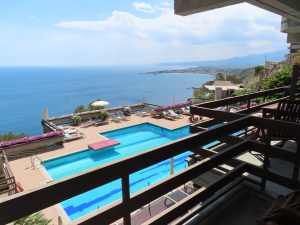
The view from Eurostars Monte Tauo, our hotel in Taormina, Sicily.
The big surprise for our tour group was the steep hill that connected the hotel to the main street. Vehicles could hardly make it down, and for the first couple days as we huffed and puffed to walk up, we weren’t sure we’d make it with enough energy left to tour. By day three, our endurance had increased but it was still challenging to safely navigate the bricked narrow steps slicing the middle of the otherwise cobbled path.
what we learned:
Don’t know if it’s that people in the cities and towns we visited don’t have clothes dryers, or just prefer the natural method of hanging clothes on a line or over a balcony railing, but no matter where we traveled, colorful clothes waved in the breeze or hung limply in the humidity. I flashed nostalgically to being a child and living in Coney Island, NY with my grandparents when my dad was on a Temporary Duty Assignment in the Air Force. If it wasn’t raining, clothes-pinned clothes fluttered from everyone’s backyard lines or draped over windowsills from upper floor dwellings.
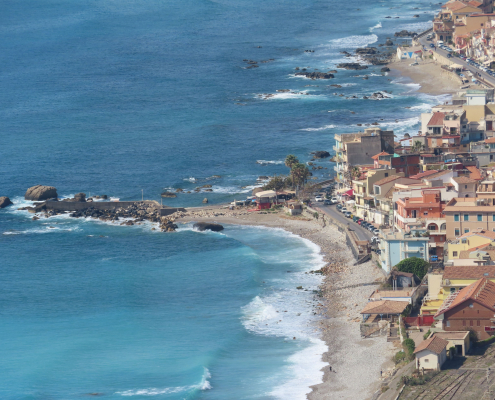
The city of Naxos hugs the coastline below Taormina.
Italy was unified in 1861. Until that time, homosexuality was not illegal in Sicily. That bode well for German photographer Wilhelm Iwan Friederich August Freiherr von Gloeden (1856 –1931), whose landscapes and pastoral nude studies of Sicilian boys posed elegantly with wreaths and amphoras (a type of pottery specifically used for transporting items) struck a chord with wealthy tourists and gay men escaping more conservative locations. They flocked to Taormina to witness beautiful men made even more flawless through Gloeden’s use of photographic filters and special body makeup he devised to disguise skin imperfections.
The Godfather movies were not shot in Corleone. Apparently, the Mafia is a bit shy about being featured in a movie that may not be all that favorable to their image. Savoca village, located east of Palermo, substituted for Corleone, but if you want to visit the actual bar, check out Bar Vitelli.
Italy is a parliamentary republic with 20 regions.
rarely reach Southern Italy.
In WWII, the Mafia assisted Americans who landed in Sicily because Lucky Luciano had visions of Sicily becoming a part of the United States. He thought the assistance would make that occur.
Sicily is like anyplace in the world: it’s who you know that matters, not what, when you want something done.
Sicily once had the biggest sulfur mine in Europe. It’s no longer in production.
I was surprised by the number and variety of cactus. I think their varieties and numbers About 60 million people reside in the country.
Italy’s history is as complicated as all the rules governing infrastructure. For instance, Sicily has a zoning rule that buildings must be at least 150 meters from the coastline, but if a natural disaster occurs, it can’t be rebuilt there.
Little money is devoted to infrastructure in Southern Italy. . We couldn’t take short, direct road routes due to many roads and bridges being unfinished. This meant constantly departing the highway for smaller back roads, adding time to the journey. Roads were patchy, but at least we weren’t on a train. Italy’s train tracks haven’t been updated since 1935, so high-speed rail is only available on two lines that connect most of the country’s major cities. Infrastructure dollars could easily compete with the southwest U.S.
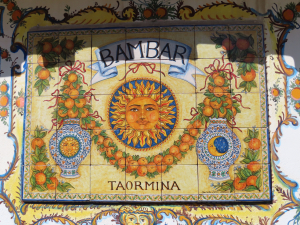
We stopped at Bam Bar for granita. Many eat it with a brioche.
There are over 250 hotels in Taormina. Tourism now fuels the economy.
Up to 18 varieties of loquats grow in Taormina.
Italy may be known for creamy gelatos, but in Sicily, there’s competition from flavored granitas, a coarse flavored ice. In Taormina, many sidewalk café customers seemed to order a brioche to eat with their granita.
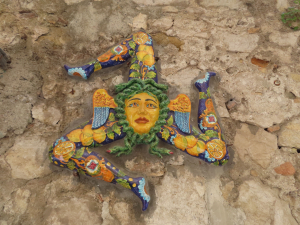
The symbol of Sicily is the Traincacria, also known as the Triskelion, adopted in 1282 by the Sicilian Vespers.
The symbol of Sicily is the Trinacria, also known as the Triskelion, adopted in 1282 by the Sicilian Vespers. The Vespers was a successful rebellion that erupted at Easter that year against the rule of the French-born king Charles I. Guess they figured 16 years of Charles I in charge was enough. The Trinacria is on the official flag of the autonomous Sicilian regions, or on souvenirs, clothes, pottery, or local crafts. Sometimes you see it as a three-legged woman and sometimes it’s just the three legs. Sicily is a triangle, so the three legs represent the three points of the island.

Pottery heads and religious symbols share space on balconies and building facades.
No matter where you look throughout Taormina, you are sure to spot pottery depicting a man and a woman’s heads. Usually sold as a set. Sometimes the heads look like African royalty. Other times less ornate. Mostly the heads are plant pots and not statuary. They reside on private balconies, in doorways of flower shops, or peeking out among other artisan crafts in local gift stores. The story behind the heads has taken on legendary myth status, evolving from medieval days when they were first crafted. The story goes that the couple was in a forbidden romance. She was a Norman, and he was either a Muslim or a Moor (depending on whose tale you learn, and it also explains why many of the heads sold are of a mixed-race couple). Her father disapproved of the man’s race or religion and had him beheaded. Bereft, she took his head and planted basil in it, which allegedly flourished. In another version, he betrayed her, so she had him beheaded, but the planted basil still flourished. As for whether basil still prospers in the ceramic man’s head, you’ll have to plant some yourself and find out.
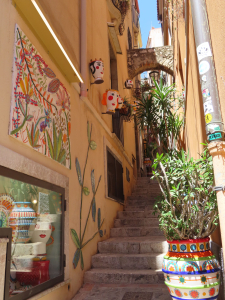
Ceramic pots of a star-crossed couple appear as planters and statuary.
Outside the Teatro Antico di Taormina (see below under what we did), our guide pointed out the wide-spreading carob tree at the entrance. Carob trees are common in Sicily. Arabs had discovered that carob seeds (karat in Arabic) are the size and shape of peas and they weighed about the same. Carob seeds became the measure for precision weighing of gold and gemstones. Twenty-four seeds became 24K. Of course, no lore exists without an alternate explanation. The term carat originates from the Greek word kerateeon, meaning “fruit of the carob”. Even with the origins of the word carob being disputed, the fact remains that they were used to weigh gold and gemstones.
There are two ancient gates on far sides of Taormina. Porta Messina Gate is the north entrance to the historical center of the town. Porta Catana Gate starts the pedestrian area.
In Part 2: TRAVELER DISCOVERIES OF SOUTHSIDE ITALY’S ANCIENT ORIGINS, we discover what we did and where we ate in Taormina.
*ALPINE ADVENTURES EXCEED EXPECTATIONS, https://karenkuzsel.com/2019/09/23/part-1-alpine-adventures-exceed-expectations-lucerne/
**DENMARK & NORWAY: ROYALLY RICH IN BREATHTAKING BEAUTY, FROM CASTLES TO FJORDS, https://karenkuzsel.com/2017/09/20/denmark-norway-royally-rich-in-breathtaking-beauty-from-castles-to-fjords-5/
www.eurostarshotels.co.uk/eurostars-monte-tauro.html
https://odysseys-unlimited.com
Karen Kuzsel is a writer-editor based in the Orlando area who specializes in the hospitality, entertainment, meetings & events industries. She is an active member of International Live Events Association and Meeting Professionals International and is now serving on the 2021-2022 MPI Global Advisory Board for Small Business Owners. She is a member of the Society of Professional Journalists. Karen writes about food & wine, spas, destinations, venues, meetings & events. A career journalist, she has owned magazines, written for newspapers, trade publications, radio and TV. As her alter-ego, Natasha, The Psychic Lady, she is a featured entertainer for corporate and social events. Karen@KarenKuzsel.com; www.KarenKuzsel.com; www.ThePsychicLady.com; @karenkuzsel; @thepsychiclady. Food photos for this series by Karen Kuzsel. All other Photos by Russ Wagner, a retired government planner/builder who has a passion for historic architecture, wine, trains, travel and taking photographs.
